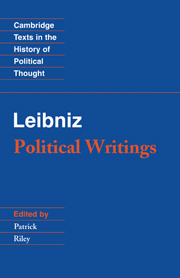Book contents
- Frontmatter
- Contents
- Preface to the Second Edition
- Abbreviations
- Introduction
- Part I On Justice and Natural Law
- Part II On Social Life, Enlightenment and the Rule of Princes
- Part III On State-Sovereignty and Hobbesian Ideas
- Part IV On the Defense of Hapsburg Europe against France
- 9 Mars Christianissimus (Most Christian War-God) (1683)
- 10 Manifesto for the Defense of the Rights of Charles III (1703)
- Part V On International Relations and International Law
- Part VI Political Letters
- Part VII Sovereignty and Divinity: Unpublished Manuscripts, 1695–1714
- Critical Bibliography
- Index
10 - Manifesto for the Defense of the Rights of Charles III (1703)
Published online by Cambridge University Press: 05 June 2012
- Frontmatter
- Contents
- Preface to the Second Edition
- Abbreviations
- Introduction
- Part I On Justice and Natural Law
- Part II On Social Life, Enlightenment and the Rule of Princes
- Part III On State-Sovereignty and Hobbesian Ideas
- Part IV On the Defense of Hapsburg Europe against France
- 9 Mars Christianissimus (Most Christian War-God) (1683)
- 10 Manifesto for the Defense of the Rights of Charles III (1703)
- Part V On International Relations and International Law
- Part VI Political Letters
- Part VII Sovereignty and Divinity: Unpublished Manuscripts, 1695–1714
- Critical Bibliography
- Index
Summary
Leibniz wrote the Manifesto during the War of the Spanish Succession to defend the rights of the House of Hapsburg to the throne of Spain, after the grandson of Louis XIV had brought Spain into the Bourbon orbit by being named King of Spain in the will of the last Hapsburg king, Charles II. In the Manifesto, Leibniz demonstrated his legal ability in a long proof of the illegality of the will of Charles II, to which he added an extremely effective, if somewhat exaggerated, account of French manners and morals, designed to prove that Spain would be ruined by the atheism and libertinism of France. This last section shows that Leibniz was a rather able (if early) sociologist, and that he perceived in 1703 some of the flaws in French society which much later writers (such as de Tocqueville) saw as the cause of the Revolution. And he anticipated Montesquieu in his dislike of the over-centralization of France since the time of Richelieu, and in his fear that the nobility had been made useless. (The present translation follows the version printed in vol. III of Foucher de Careil's edition of Leibniz; since the work is somewhat repetitious some passages, merely reenforcing arguments which are already clear, have been cut.)
- Type
- Chapter
- Information
- Leibniz: Political Writings , pp. 146 - 164Publisher: Cambridge University PressPrint publication year: 1988



